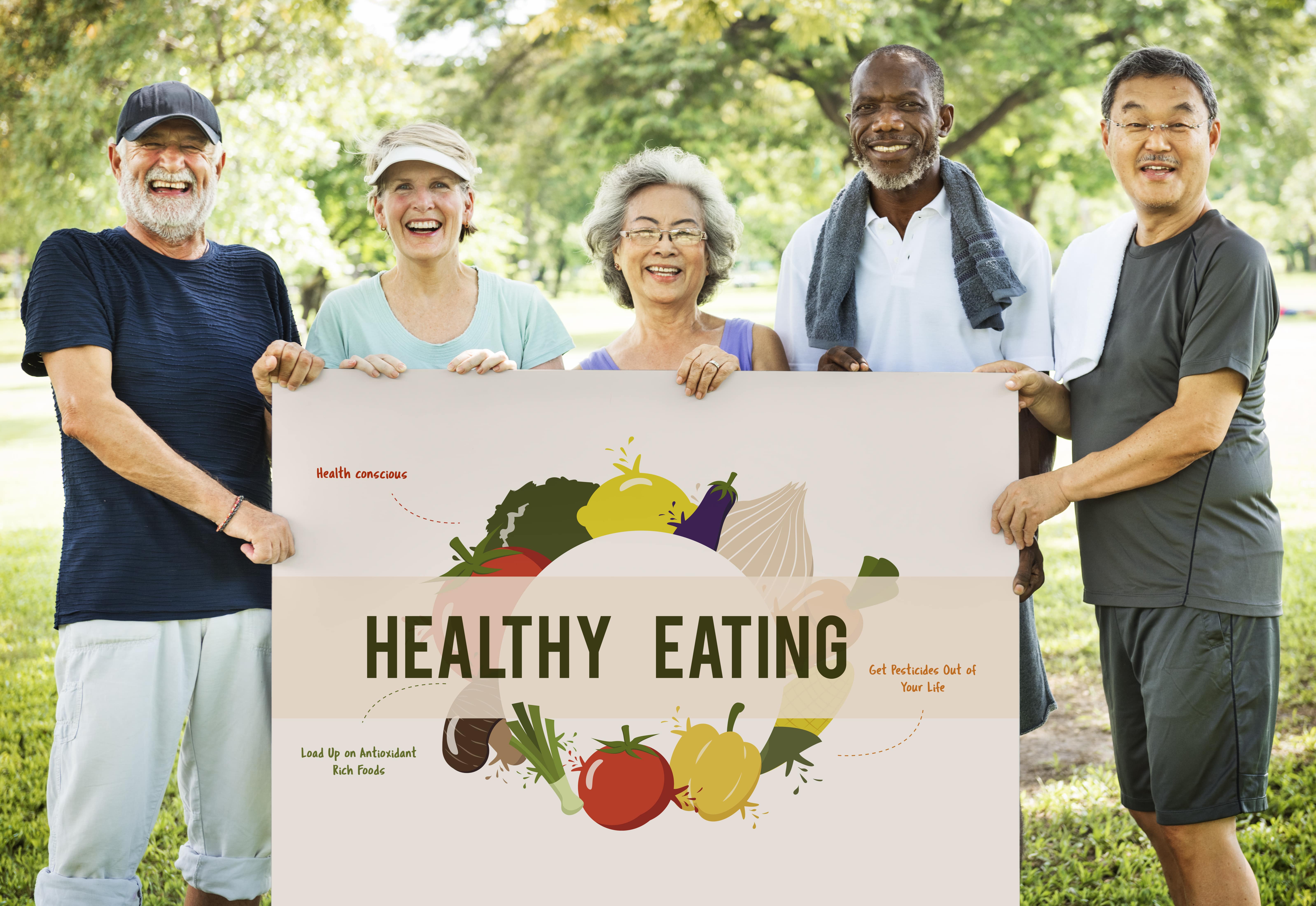What Foods Are Good for People Over Age 50 To Eat?

Eating a diverse range of foods from various nutrition kinds can help provide the nutrients that an individual requires as they age. When you’re in your 50s, it’s crucial to adopt dietary and lifestyle modifications that will help you acquire the nutrients you need later in life. What’s on your plate should change over time, just as our bodies do. And, while you may have had the choice of eating a doughnut or two in your twenties, it can have a bigger impact on your glucose levels and risk of diabetes and heart disease as you become older. Also, if you’ve been diagnosed with any conditions that necessitate dietary changes, you’ll need to make changes to monitor and develop possible symptoms.
Regardless of whether you’re not told by your doctor to change your eating routine, it’s brilliant to roll out certain improvements all alone whenever you’ve arrived at your 50s. At this age, there are a few good dietary habits to adopt.
-
Consume foods that are high in protein
While having enough protein is vital at any age, persons in their 50s and older have higher protein needs since their muscles need that extra boost for strength and repair after activity, and they can’t use protein as efficiently as they could earlier in life. Even if you’re not nearly 50, protein-rich foods can help you stay satisfied, so eating a little more isn’t a bad idea. Choose lean meats like steak, fish, chicken breast, and turkey, and plant-based foods like tofu, lentils, and quinoa to satisfy your hunger.
-
Berries
Berries are abundant in fiber, vitamin C, and anti-inflammatory, antioxidant flavonoids, making them one-stop nutrition for folks over the age of 50. According to Nancy Farrell Allen, a registered dietitian and nutritionist with the Academy of Nutrition and Dietetics; Fiber keeps us regular, helps us manage our weight, and protects us from diseases like diabetes, heart disease, and cancer. Men above the age of 50 should consume 30 grams per day, while women above the age of 50 should consume 21 grams per day.
Berries appear to be beneficial to our aging brains as well. Berries are high in antioxidants, which may help with motor skills and short-term memory. A Tuft’s University research examined dietary habits of 2,800 adults aged 50 and above within the range of 20 years and discovered that those who ate less flavonoid-rich foods like berries, apples, and tea were two to four times more likely to acquire dementia.
-
Seafood
Studies show that older adults should be more aware of protein intake because their bodies are less efficient at utilizing protein than middle-aged people. Salmon, cod, tuna, and trout are lean protein sources that help older adults maintain or recover muscle mass.
Fish is also high in vitamin B12, a substance that can only be found in animal foods. Older adults have a harder time absorbing as they get older. Omega-3 fatty acids are also found in seafood.
-
Consume Calcium-Rich Foods
As you get older, your bone density decreases, so you need calcium-rich foods to maintain bone strength and stability, reduce your risk of osteoporosis, and prevent fractures and damage. Calcium requirements for women increase from 1,000 mg to 1,200 mg per day at the age of 50. You can also consider the Mediterranean diet, which has been shown to reduce the incidence of osteoporosis. It is high in fish, vegetables, dairy, and grains, and low in processed, high-sugar foods. Milk, cheese, Greek yogurt, fortified non-dairy milk, eggs, and leafy greens are all excellent calcium sources.
Nuts
Eating nuts rather than chips, crackers, or cookies is a simple approach to improve your nutrition. In a randomized controlled experiment done in Spain in 2013, it was discovered that consuming an ounce of mixed nuts daily as part of a Mediterranean-style diet lowered the risk of heart attack, stroke, and death from heart disease by 28%. Also, don’t forget about peanuts, which are just as healthful as almonds and other tree nuts but cost roughly half as much. Use chopped, toasted nuts as a garnish for roasted vegetables or whole-grain sides like brown rice and quinoa to get in a daily dose.

Kale
According to Trista Best, MPH, RD, LD of Balance One Supplements. Antioxidant-rich foods should be consumed in moderation by anyone over the age of 50. Antioxidants are plant components that activate the immune system while also preventing blood platelet clumping, which reduces inflammation, chronic, low-level inflammation leads to oxidative stress in the body, which contributes too many of the chronic diseases that plague Western societies. Heart disease, obesity, and diabetes are the most prevalent illnesses caused by inflammation. Kale is one of the best antioxidant-rich foods to include in your diet.
The antioxidants in this healthy food come in the form of a range of vitamins, minerals, and plant chemicals. Kale has a low calorie per pound, making it an ideal salad or smoothie foundation because it adds bulk without adding calories. This will aid weight loss attempts by activating the gut’s stretch receptors, which will provide a sense of satiety without adding calories.
Leafy Greens
Adding spinach, kale, collards, or other leafy greens to your meals may help you maintain mental sharpness as you age. According to studies at the American Society for Nutrition annual meeting, persons over the age of 50 who ate one to two servings of greens per day had the same cognitive performance as people 11 years younger who rarely ate greens.
Oats
Men over 50 and women over 55 are at a higher risk of heart disease, so adding additional cholesterol-lowering foods like oats to your diet is a good idea. Oats are high in beta-glucan, a kind of dietary fiber that has been found to lower cholesterol levels by 5 to 10% when consumed at least 3 grams per day (equal to 1.5 cups cooked oats). People who eat oats and other whole grains regularly have a lower risk of dying young. Plain oats are less expensive than boxed cereals and make an excellent vehicle for other nutritious components such as nuts, seeds, and fruit.
Water
As you become older, you need to pay greater attention to hydration. As we get older, we don’t have as good a thirst mechanism, says Rosenbloom, who advises keeping track of your water intake, especially when it’s hot and humid and you’re sweating — such as when gardening outside. Drinking more water can help prevent the consequences of aging gut function. Also, keep in mind that we frequently mistakenly believe we are hungry when we are truly thirsty.
What should you look out for?
According to Marie Bernard, M.D., deputy director of the National Institute on Aging (NIA) and NIA’s senior geriatrician, older adults need to make sure they’re getting lots of fruits and vegetables, eating lean meats if they’re eating meat, chicken, or fish, and avoiding saturated fats and sugars.
After age 50, our metabolism begins to gradually decline, which means we have to be even more selective about the foods we eat. Eating a variety of selected foods is the key to a healthy diet. It’s important to take a hard look at your diet after age 50. Around that point, experts say, it pays to be choosier about your foods, and make sure you’re getting enough nutritional bangs for your buck.
A healthy diet can help control blood pressure, reduce the risk of heart disease, and contribute to the prevention of diseases like diabetes and cancer.
Related Posts
Should I Exercise Over Age 50?
Hey there! Just relaxing sounds pretty amazing, right? You may have time to travel, indulge…
04 January, 2022What Types Of Vitamins Are Good For People To Take Over Age 50?
Aging brings about wrinkles, diminished hearing, forgetfulness, and the emergence of gray hair. Amidst these…
04 January, 2022

